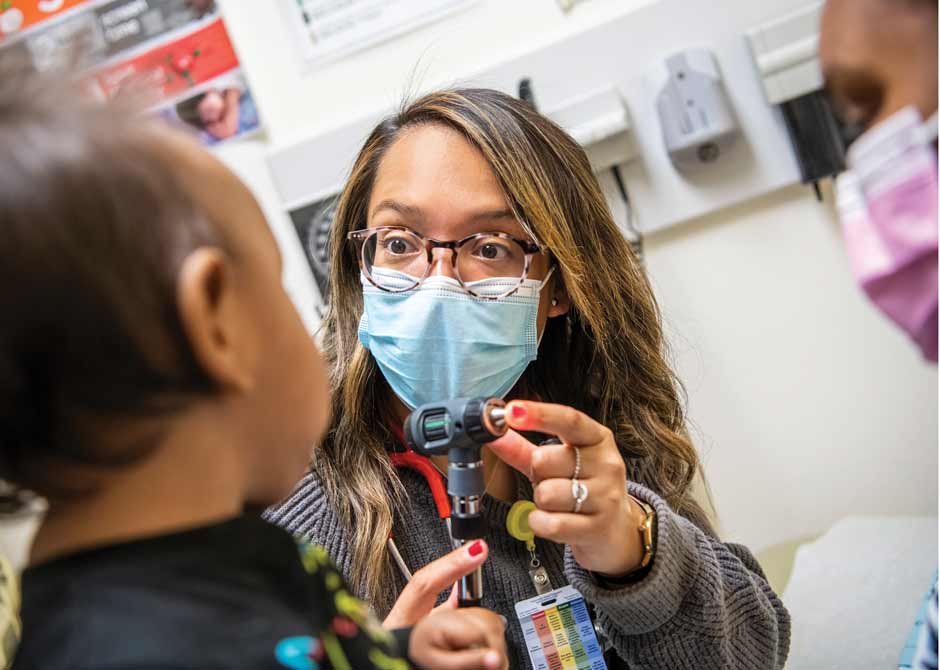 From filling gaps in resources and health care for Columbus residents to implementing evidence-based intervention in Ohio communities battling the opioid epidemic, The Ohio State University College of Medicine and The Ohio State University Wexner Medical Center are deeply invested in community health. Teams are delivering on the mission of transforming the health of communities through inclusive and innovative education, discovery and care.
From filling gaps in resources and health care for Columbus residents to implementing evidence-based intervention in Ohio communities battling the opioid epidemic, The Ohio State University College of Medicine and The Ohio State University Wexner Medical Center are deeply invested in community health. Teams are delivering on the mission of transforming the health of communities through inclusive and innovative education, discovery and care.
In recognition of Ohio State’s ongoing work to improve health and wellness across the state, the Association of American Medical Colleges (AAMC) has awarded the college its 2022 Spencer Foreman Award for Outstanding Community Engagement. This prestigious award acknowledges the college’s commitment to partnering with diverse stakeholders and community residents to identify and address community needs.
Carol R. Bradford, MD, MS, FACS, dean of the Ohio State College of Medicine, says the college’s deep commitment to community engagement is illustrated through decades-long programming and community health initiatives, which are possible due to the passion and commitment on the part of more than 30,000 faculty, staff, learners and community partners.
“It is not just one or two projects we focus on. Serving communities throughout Ohio is ingrained in everything we do at the college,” Dr. Bradford says. “We work with different communities to discover their needs and implement ongoing solutions that can be sustained. Our primary goal is to transform the health of Ohio and beyond.”
The community health projects behind the recognition
Partners Achieving Community Transformation (PACT):
When the Columbus Public Health Department identified Columbus’ Near East Side as a community in need of expanded access to health care, the Ohio State College of Medicine and Wexner Medical Center partnered with the city of Columbus and the Columbus Metropolitan Housing Authority to form PACT, pledging more than $10 million to improve health and wellness in this community. One of PACT’s first projects was to restore properties in the area, acquiring home repair grants for 26 homes and initiating down-payment grants that encouraged 31 Ohio State employees to move into neighborhoods on the Near East Side.
The Health Sciences Academies (HSA):
In 2014, PACT, Columbus City Schools and the Ohio State Wexner Medical Center teamed up to establish the HSA at six Near East Side public schools, where every student participates in health science education. Each week, high school students participate in the Health Science Career Connections Club and learn from professionals in health science fields, engage in mentoring opportunities with Ohio State medical students, complete community service projects and learn professional skills. They then have opportunities to attend Ohio State career fairs, and MD and veterinarian camps. Sixth-grade students are given a White Coat Ceremony to mark their transition into the HSA each year. HSA also provides training programs for students’ parents to help them understand the HSA, how to make healthier choices and how to access medical care.
Moms2B:
This community-based pregnancy program for low-income women was established by Ohio State in 2010 and is supported by Wexner Medical Center. Moms2B’s goal is to improve the health of at-risk communities, empower pregnant women to deliver full-term healthy babies, reduce the number of low birthweight infants, reduce infant mortality and eliminate racial and economic disparities. Mom2B is using research, treatment programs and community outreach to reduce those disparities, and has helped more than 3,000 parents. Since the establishment of Moms2B, preterm births, very preterm births and low birthweight have been reduced by 20% and infant mortality has been reduced 55%.
The Interprofessional Community Scholars Program:
Learners work directly in the community to improve the reach and quality of health care. The program brings students from multiple disciplines together with people living in the Near East Side to address care gaps. The Community Health Education course pairs medical students with approximately 30 community organizations, where they improve community health as part of their education.
The Columbus Free Clinic:
This primary and urgent care walk-in clinic is managed by Ohio State medical students under the supervision of volunteer physicians and serves more than 1,400 underserved and uninsured patients annually. Students work alongside social workers, pharmacists, lab technicians, nurses and faculty mentors in a collaborative setting to address medical, social, mental health and even housing needs. In addition, patients are referred to specialty clinics in psychiatry, gynecology, law, orthopaedics, LGBTQ patient care and others for additional treatment.
HEALing Communities Study:
With our Carnegie R1 status as one of the country’s leading research institutions, Ohio State holds many grants that address community health. One of the largest, the HEALing Communities Study, aims to reduce opioid overdose deaths by 40% over three years in participating communities, under a cooperative agreement supported by the National Institutes of Health’s National Institute on Drug Abuse. A statewide effort, Ohio State is partnering with the University of Cincinnati, Case Western, RecoveryOhio and 19 at-risk Ohio counties, along with cabinet-level state officials and community leaders, to identify which components of evidence-based interventions lead to a reduction in opioid overdose deaths. This is accomplished through a mix of clinical interventions, health-based communications and data systems to improve community outcomes in a state that is commonly considered “ground zero” for the opioid epidemic.
